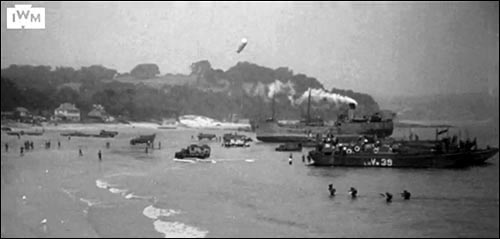Site of D-Day landings exercise, Amroth
![]()
![]() Site of D-Day landings exercise, Amroth
Site of D-Day landings exercise, Amroth
 A major exercise to prepare the armed forces for the D-Day landings was carried out along this stretch of the coast in 1943. The photos shown here, courtesy of the Imperial War Museum, are from a War Office film which you can view online – see link below.
A major exercise to prepare the armed forces for the D-Day landings was carried out along this stretch of the coast in 1943. The photos shown here, courtesy of the Imperial War Museum, are from a War Office film which you can view online – see link below.
Before the Allies attempted to land on the Normandy beaches in June 1944, it was imperative that they practised landing troops and supplies from the sea. One exercise took place on these beaches in July 1943 and was codenamed Exercise Jantzen. It was primarily to rehearse the unloading of coasters after the beachhead had been secured. For the purpose of this exercise, it was assumed that the coast was already secure.
Ships were loaded with thousands of tonnes of supplies and military equipment and set sail from Tenby, Swansea and Port Talbot destined for the south-east Pembrokeshire coast. The beaches were chosen for their similarity to those in Normandy. As on D-Day itself, the beaches were sub-divided into sectors. Over the 13-day exercise, 16,230 tonnes of supplies were brought ashore. That may seem a lot, but it was significantly less than the 23,400 tonnes target.
 Residents were banned from the beaches during the exercise, and police enforced a curfew. Several roadways were bulldozed through the natural bank of pebbles which lined Amroth beach. This weakened local sea defences, and eventually the Government helped to fund sea walls and groynes. An abandoned landing craft was visible on Amroth beach for years, until it settled below the sand.
Residents were banned from the beaches during the exercise, and police enforced a curfew. Several roadways were bulldozed through the natural bank of pebbles which lined Amroth beach. This weakened local sea defences, and eventually the Government helped to fund sea walls and groynes. An abandoned landing craft was visible on Amroth beach for years, until it settled below the sand.
The Allies learnt a great deal from Exercise Jantzen, including many of the shortcomings of unloading equipment from beached ships and barges. The failings may have proved to the military authorities that the most efficient way of unloading troops and equipment at a secured beachhead was to build an artificial harbour. Ultimately, this is what happened at Normandy with the building of Port Winston at Arromanches. Parts for this ‘Mulberry’ harbour were piloted in Conwy and built at sites around Britain.
According to local folklore, Prime Minister Winston Churchill was one of the interested spectators who witnessed Exercise Jantzen and he drank tea at a hostelry in Wiseman’s Bridge, where the beach was also used for the exercise.
About the place name:
Amroth means ‘by the (river) Rhath’. It includes am (around, surrounding) and rhath (a defence).
With thanks to Adrian Hughes, Mark Harvey, Jason Lawday, the IWM and Prof Dai Thorne, of the Welsh Place-Name Society
Exercise Jantzen film on IWM website (IWM catalogue number DRA 711)

